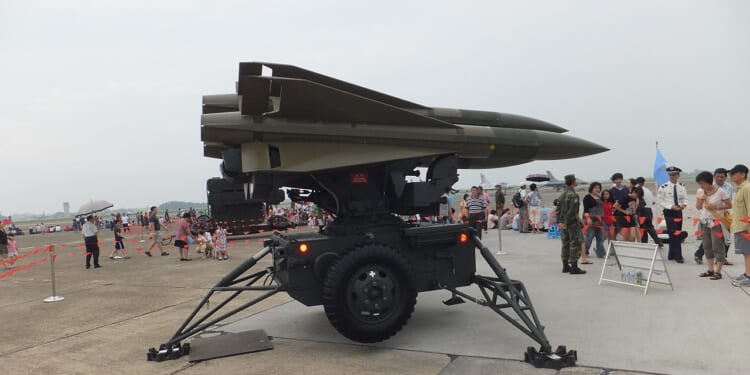The only “hellscape” being created is whatever is happening at the Defense Autonomous Warfare Group (DAWG) to complicate what should have been a straightforward defense project.
The democratic self-governing island of Taiwan is threatened as never before by China, its hulking neighbor. Given the importance of Taiwan to the global economy—it has a vaunted role as the world’s leading producer of semiconductors—the United States has long understood that Taiwan’s ability to defend itself is a vital strategic imperative for America’s own interests. As an ally of Taiwan, the US has also worked to improve Taiwan’s defenses, turning it into an unconquerable porcupine.
Yet here, as elsewhere, the ineffectiveness of America’s defense industry has obstructed these efforts. Just look at the crisis affecting the “Replicator Project,” a no-brainer project aimed at improving Taiwan’s local defenses. That program has hit a real snag.
Described by the US military in 2024 as aiming to create a “hellscape” around Taiwan with swarms of supposedly cheaply produced, highly effective American drones, the ambitious program is already collapsing under its own optimism.
The Replicator Project Has the Pentagon’s Classic Problem: Bloat
Recent reports in US media suggest that the Pentagon is becoming frustrated by the lack of progress on this important program. The drones involved in this ambitious attempt to more thoroughly defend Taiwan are far from cheap, as their proponents had initially claimed. In fact, many of the systems involved in this massive undertaking—such as the Switchblade 300 anti-tank loitering munition—costs a staggering $90,000 per unit, whereas the off-the-shelf commercial drones that the Ukrainians have fashioned into warfighting platforms cost around $700!
Software failures, navigational glitches, test crashes, and infighting on the project are all leading to a breakdown. While the Replicator Project takes direct inspiration from the Ukraine War and how both sides in that nasty fight have innovated drones for their own purposes, it should be noted that drones in the Ukraine War are also facing increasingly effective countermeasures. For instance, Ukraine’s military, which has integrated drone warfare at nearly every operational level, is finding that their Russian rivals have effectively developed jamming techniques that render many of the Ukrainian drone swarms inoperable.
On top of that, the Trump administration doesn’t think that the program, inherited from the much-maligned Biden administration, is working as advertised. Earlier this year, Secretary of Defense Pete Hegseth fired Rear Admiral Kevin Smith, the project lead, due to disagreements with how the program should be administered.
Can Taiwan’s Drone Project Be Saved?
The Replicator Project is becoming a victim of what so many interesting weapons projects in the Pentagon fall prey to: a horrific acquisitions cycle that sees rising costs and shrinking numbers resulting from these inefficiencies in the Pentagon’s acquisitions process generally and, more specifically, in the Replicator Project itself.
What’s more, the fixation on swarms of lightweight, short-range drones might be ill-suited to the kind of fight that such systems would have to wage if they were deployed against a possible Chinese invasion of Taiwan. The key to properly defending Taiwan, whether it be using drones or more conventional methods, would be in the ability to destroy Chinese warships and amphibious landers.
That requires serious firepower and range. Drones come in all shapes and sizes. And a swarm of them can pack a punch, if need be. But the systems being developed as part of Project Replicator might not be the best suited for the task of threatening Chinese warships and amphibious landers. Plus, there is a real problem with scaling these systems at cost.
In short, the Replicator Project shows how a good concept can be undermined not by the enemy, but by faulty assumptions on the part of project leaders and a broken defense industrial base. The only “hellscape” being created is whatever is happening at the Defense Autonomous Warfare Group (DAWG) to complicate what should have been a straightforward defense project.
About the Author: Brandon J. Weichert
Brandon J. Weichert is a senior national security editor at The National Interest. Recently, Weichert became the host of The National Security Hour on America Outloud News and iHeartRadio, where he discusses national security policy every Wednesday at 8pm Eastern. He is also a contributor at Popular Mechanics and has consulted regularly with various government institutions and private organizations on geopolitical issues. Weichert’s writings have appeared in multiple publications, including The Washington Times, National Review, The American Spectator, MSN, The Asia Times, and others. His books include Winning Space: How America Remains a Superpower, Biohacked: China’s Race to Control Life, and The Shadow War: Iran’s Quest for Supremacy. His newest book, A Disaster of Our Own Making: How the West Lost Ukraine is available for purchase wherever books are sold. He can be followed via Twitter @WeTheBrandon.
Image: Wikimedia Commons.


















